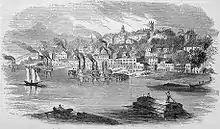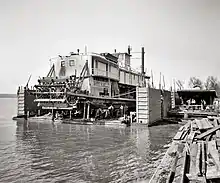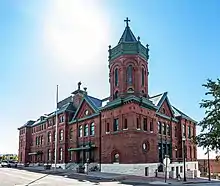History of Vicksburg, Mississippi
First People
The area that is now Vicksburg was long occupied by the Natchez Native Americans as part of their historical territory along the Mississippi. The Natchez spoke a language isolate not related to the Muskogean languages of the other major tribes in the area. Before the Natchez, other indigenous cultures had occupied this strategic area for thousands of years.
European settlement
The first Europeans who settled the area were French colonists who built Fort Saint Pierre in 1719 on the high bluffs overlooking the Yazoo River at present-day Redwood. They conducted fur trading with the Natchez and others, and started plantations. On 29 November 1729, the Natchez attacked the fort and plantations in and around the present-day city of Natchez. They killed several hundred settlers, including Jesuit missionary Paul Du Poisson. As was the custom, they took a number of women and children as captives, adopting them into their families.
The Natchez War was a disaster for French Louisiana, and the colonial population of the Natchez District never recovered. Aided by the Choctaw, traditional enemies of the Natchez, though, the French defeated and scattered the Natchez and their allies, the Yazoo.
The Choctaw Nation took over the area by right of conquest and inhabited it for several decades. Under pressure from the US government, the Choctaw agreed to cede nearly 2,000,000 acres (8,100 km2) of land to the US under the terms of the Treaty of Fort Adams in 1801. The treaty was the first of a series that eventually led to the removal of most of the Choctaw to Indian Territory west of the Mississippi River in 1830. Some Choctaw remained in Mississippi, citing article XIV of the Treaty of Dancing Rabbit Creek; they became citizens of the state and the United States. They struggled to maintain their culture against the pressure of the binary slave society, which classified people as only white or black.
In 1790, the Spanish founded a military outpost on the site, which they called Fort Nogales (nogales meaning "walnut trees"). When the Americans took possession in 1798 following the American Revolutionary War and a treaty with Spain, they changed the name to Walnut Hills. The small village was incorporated in 1825 as Vicksburg, named after Newitt Vick, a Methodist minister who had established a Protestant mission on the site.[1]


The town of Vicksburg was incorporated in 1825, with a population of 3,000 people; of which approximately twenty people were Jewish and had immigrated from Bavaria, Prussia, and Alsace–Lorraine.[2][3]
In 1835, during the Murrell Excitement, a mob from Vicksburg attempted to expel the gamblers from the city, because the citizens were tired of the rougher element treating the city residents with nothing but contempt. They captured and hanged five gamblers who had shot and killed a local doctor.[4] Historian Joshua D. Rothman calls this event "the deadliest outbreak of extralegal violence in the slave states between the Southampton Insurrection and the Civil War."[5]
In 1862, fifty Jewish families formed the Hebrew Benevolent Congregation Anshe Chesed in Vicksburg, and received a charter from the state.[6] Two years later in 1864, the Anshe Chesed Cemetery was formed, and it was the second Jewish cemetery in the city; not much is known about the first Jewish cemetery.[2][7]
Civil War
During the American Civil War (1861–1865), the city finally surrendered during the Siege of Vicksburg, after which the Union Army gained control of the entire Mississippi River. The 47-day siege was intended to starve the city into submission. Its location atop a high bluff overlooking the Mississippi River proved otherwise impregnable to assault by federal troops. The surrender of Vicksburg by Confederate General John C. Pemberton on July 4, 1863, together with the defeat of General Robert E. Lee at Gettysburg the day before, has historically marked the turning point of the Civil War in the Union's favor.
From the surrender of Vicksburg until the end of the war in 1865, the area was under Union military occupation.[8]
The Confederate president, Jefferson Davis, was based at his family plantation at Brierfield, just south of the city.
Losing of Mississippi access and commercial status

Because of Vicksburg's location on the Mississippi River, it built extensive trade from the prodigious steamboat traffic in the 19th century. It shipped out cotton coming to it from surrounding counties and was a major trading city in West Central Mississippi.
However, in 1876, a Mississippi River flood cut off the large meander next to Vicksburg through the De Soto Point, which changed the Mississippi River's course away from the city. Vicksburg only retained access to an oxbow lake formed from the old channel of the river, which effectively isolated the city from accessing the Mississippi riverfront. The city's economy suffered greatly due to the lack of a functional river port; Vicksburg would not be a river town again until the completion of the Yazoo Diversion Canal in 1903 by the U.S. Army Corps of Engineers.[9]
Between 1881 and 1894, the Anchor Line, a prominent steamboat company on the Mississippi River from 1859 to 1898, operated a steamboat called the City of Vicksburg.
Political and racial unrest after Civil War
Celebrations of the 4th of July, the day of surrender, were irregular until 1947. The Vicksburg Evening Post of July 4, 1883, called July 4 "the day we don't celebrate",[10] and another Vicksburg newspaper, the Daily Commercial Appeal, in 1888 hoped that a political victory would bring an enthusiastic celebration the following year.[11] In 1902, the 4th of July saw only "a parade of colored draymen".[12] In 1947, the Jackson Clarion-Ledger stated that the city of Vicksburg did not celebrate the 4th of July again until 1945, and then it was celebrated as Confederate Carnival Day.[13] A recent scholar disagrees, stating that large Fourth of July celebrations were being held by 1907, and informal celebrations before that.[14][15] A large parade was held in 1890.[16]
In the first few years after the Civil War, white Confederate veterans developed the Ku Klux Klan, beginning in Tennessee; it had chapters throughout the South and attacked freedmen and their supporters. It was suppressed about 1870. By the mid-1870s, new white paramilitary groups had arisen in the Deep South, including the Red Shirts in Mississippi, as whites struggled to regain political and social power over the black majority. Elections were marked by violence and fraud as white Democrats worked to suppress black Republican voting.
In August 1874, a black sheriff, Peter Crosby, was elected in Vicksburg. Letters by a white planter, Batchelor, detail the preparations of whites for what he described as a "race war," including acquisition of the newest Winchester guns. On December 7, 1874, white men disrupted a black Republican meeting celebrating Crosby's victory and held him in custody before running him out of town.[17] He advised blacks from rural areas to return home; along the way, some were attacked by armed whites. During the next several days, armed white mobs swept through black areas, killing other men at home or out in the fields, in what would come to be known as the Vicksburg Massacre. Sources differ as to total fatalities, with 29–50 blacks and 2 whites reported dead at the time. Twenty-first-century historian Emilye Crosby estimates that 300 blacks were killed in the city and the surrounding area of Claiborne County, Mississippi.[18] The Red Shirts were active in Vicksburg and other Mississippi areas, and black pleas to the federal government for protection were not met.
At the request of Republican Governor Adelbert Ames, who had left the state during the violence, President Ulysses S. Grant sent federal troops to Vicksburg in January 1875. In addition, a congressional committee investigated what was called the "Vicksburg Riot" at the time (and reported as the "Vicksburg Massacre" by northern newspapers.) They took testimony from both black and white residents, as reported by the New York Times, but no one was ever prosecuted for the deaths. The Red Shirts and other white insurgents suppressed Republican voting by both whites and blacks; smaller-scale riots were staged in the state up to the 1875 elections, at which time white Democrats regained control of a majority of seats in the state legislature.
Under new constitutions, amendments and laws passed between 1890 in Mississippi and 1908 in the remaining southern states, white Democrats disenfranchised most blacks and many poor whites by creating barriers to voter registration, such as poll taxes, literacy tests, and grandfather clauses. They passed laws imposing Jim Crow and racial segregation of public facilities.
On March 12, 1894, the popular soft drink Coca-Cola was bottled for the first time in Vicksburg by Joseph A. Biedenharn, a local confectioner. Today, surviving 19th-century Biedenharn soda bottles are prized by collectors of Coca-Cola memorabilia. The original candy store has been renovated and is used as the Biedenharn Coca-Cola Museum.
20th century to present

The exclusion of most blacks from the political system lasted for decades until after Congressional passage of civil rights legislation in the mid-1960s. Lynchings of blacks and other forms of white racial terrorism against them continued to occur in Vicksburg after the start of the 20th century. In May 1903, for instance, two black men charged with murdering a planter were taken from jail by a mob of 200 farmers and lynched before they could go to trial.[19] In May 1919, as many as a thousand white men broke down three sets of steel doors to abduct, hang, burn and shoot a black prisoner, Lloyd Clay, who was falsely accused of raping a white woman.[20][21] From 1877 to 1950 in Warren County, 14 African Americans were lynched by whites, most in the decades near the turn of the century.[22]
The United States Army Corps of Engineers diverted the Yazoo River in 1903 into the old, shallowing channel to revive the waterfront of Vicksburg. The port city was able to receive steamboats again, but much freight and passenger traffic had moved to railroads, which had become more competitive.
Railroad access to the west across the river continued to be by transfer steamers and ferry barges until a combination railroad-highway bridge was built in 1929. After 1973, Interstate 20 bridged the river. Freight rail traffic still crosses by the old bridge. North-south transportation links are by the Mississippi River and U.S. Highway 61. Vicksburg has the only crossing over the Mississippi River between Greenville and Natchez, and the only interstate highway crossing of the river between Baton Rouge and Memphis.
During the Great Mississippi Flood of 1927, in which hundreds of thousands of acres were inundated, Vicksburg served as the primary gathering point for refugees. Relief parties put up temporary housing, as the flood submerged a large percentage of the Mississippi Delta.
Because of the overwhelming damage from the flood, the US Army Corps of Engineers established the Waterways Experiment Station as the primary hydraulics laboratory, to develop protection of important croplands and cities. Now known as the Engineer Research and Development Center, it applies military engineering, information technology, environmental engineering, hydraulic engineering, and geotechnical engineering to problems of flood control and river navigation.
In December 1953, a severe tornado swept across Vicksburg, causing 38 deaths and destroying nearly 1,000 buildings.
During World War II, cadets from the Royal Air Force, flying from their training base at Terrell, Texas, routinely flew to Vicksburg on training flights. The town served as a stand-in for the British for Cologne, Germany, which is the same distance from London, England as Vicksburg is from Terrell.[23]
Particularly after World War II, in which many blacks served, returning veterans began to be active in the civil rights movement, wanting to have full citizenship after fighting in the war. In Mississippi, activists in the Vicksburg Movement became prominent during the 1960s.
Early twenty-first century Vicksburg
In 2001, a group of Vicksburg residents visited the Paducah, Kentucky, mural project, looking for ideas for their own community development.[24] In 2002, the Vicksburg Riverfront murals program was begun by Louisiana mural artist Robert Dafford and his team on the floodwall located on the waterfront in downtown.[25] Subjects for the murals were drawn from the history of Vicksburg and the surrounding area. They include President Theodore Roosevelt's bear hunt, the Sultana, the Sprague, the Siege of Vicksburg, the Kings Crossing site, Willie Dixon, the Flood of 1927, the 1953 Vicksburg, Mississippi tornado, Rosa A. Temple High School (known for integration activism) and the Vicksburg National Military Park.[26] The project was finished in 2009 with the completion of the Jitney Jungle/Glass Kitchen mural.[25]
In the fall of 2010, a new 55-foot mural was painted on a section of wall on Grove Hill across the street from the original project by former Dafford muralists Benny Graeff and Herb Roe. The mural's subject is the annual "Run thru History" held in the Vicksburg National Military Park.[27][28]
On December 6–7, 2014, a symposium was held on the 140th anniversary of the 1874 riots. A variety of scholars gave papers and an open panel discussion was held on the second day at the Vicksburg National Military Park, in collaboration with the Jacqueline House African American Museum.[29]
References
- Picturesque Vicksburg and the Yazoo Delta (PDF). Vicksburg Printing and Publishing Co. 1895. p. 11.
- "National Register of Historic Places Inventory/Nomination: Anshe Chesed Cemetery". National Park Service. 2014. Retrieved May 13, 2023.
- "Looking Back: B.B. Club is but one branch of Vicksburg's Jewish roots". The Vicksburg Post. 2022-08-10. Retrieved 2023-05-14.
- "THE VICKSBURG FLATBOAT WAR OF 1838 AND ITS INFLUENCE ON SUBMERGED LANDS LAW IN MISSISSIPPI". Masglp.olemiss.edu. Retrieved 2014-06-13.
- Rothman, Joshua D. (1 November 2012). Flush Times and Fever Dreams: A Story of Capitalism and Slavery in the Age of Jackson. University of Georgia Press. p. 249. ISBN 978-0-8203-3326-7.
- "Looking Back: B.B. Club is but one branch of Vicksburg's Jewish roots". The Vicksburg Post. 2022-08-10. Retrieved 2023-05-14.
- Surratt, John (August 1, 2021). "Windows from historic Vicksburg Jewish temple up for auction". The Vicksburg Post.
- Cotton, Gordon; Mason, Ralph (1991). With Malice Toward Some : The Military Occupation of Vicksburg, 1864 - 1865. Vicksburg and Warren County Historical Society.
- "Water Returned to City's Doorstep 100 Years Ago". Vicksburg Post. January 27, 2003. Retrieved 26 December 2020.
- "Local Items". Vicksburg Evening Post. July 4, 1883. p. 4.
- "The Fourth of July". Daily Commercial Herald (Vicksburg, Mississippi). July 4, 1888. p. 2.
- "10 Years Ago in Vicksburg". Vicksburg Evening Post. July 6, 1912. p. 6.
- "Vicksburg plans big things for Confederate carnival". Clarion-Ledger (Jackson, Mississippi). June 8, 1947. p. 19.
- Waldrep, Christopher (2005). Vicksburg's Long Shadow: The Civil War Legacy Of Race And Remembrance. Rowman & Littlefield. p. 247. ISBN 978-0742548688.
- Historian Michael G. Ballard, in his Vicksburg campaign history, pp. 420-21, claims that this story has little foundation in fact. Although it is unknown whether city officials sanctioned the day as a local holiday, Southern observances of July 4 were for many years characterized more by family picnics than by formal city or county activities.
- "20 Years Ago in Vicksburg". Vicksburg Evening Post. July 5, 1910. p. 3.
- Hahn, Steven (2003). A Nation Under Our Feet: Black Political Struggles in the Rural South from Slavery to the Great Migration. Harvard University Press. p. 297.
- Emilye Crosby, Little Taste of Freedom: The Black Freedom Struggle in Claiborne County, Mississippi, Univ of North Carolina Press, 2006, p. 3
- "Lynched for Murder…". New York Times. May 4, 1903.
- "Mob uses Rope, to Lynch Negro". Atlanta Constitution. 15 May 1919.
- McWhirter, Cameron (2011). Red Summer The Summer of 1919 and the Awakening of Black America. Henry Holt and Company. p. 51. ISBN 9780805089066.
- "Lynching in America, 3rd edition, 2017; SUPPLEMENT: Lynchings by County, p. 7" (PDF). Eji.org. Archived from the original (PDF) on 23 October 2017. Retrieved 25 January 2019.
- AT6 Monument
- "It Took A Community To Raise A Mural!", Vicksburg Riverfront Murals
- "Celebrating Vicksburg: A Great American Community", Vicksburg Riverfront Murals
- "Vicksburg Riverfront Murals". Riverfrontmurals.com. Retrieved 25 January 2019.
- "081110". Issuu.com. Retrieved 25 January 2019.
- "101310". Issuu.com. Retrieved 25 January 2019.
- "140th Anniversary Vicksburg Riots Symposium", Press release, 6 November 2014, National Park Service, accessed 15 June 2015
